Arnica and yarrow skin cream is a super soothing, thick and moisturizing cream that boasts amazing benefits for the skin. This is a wonderful homemade skin cream recipe that is easy enough for anyone to make, from beginners to seasoned herbalists!
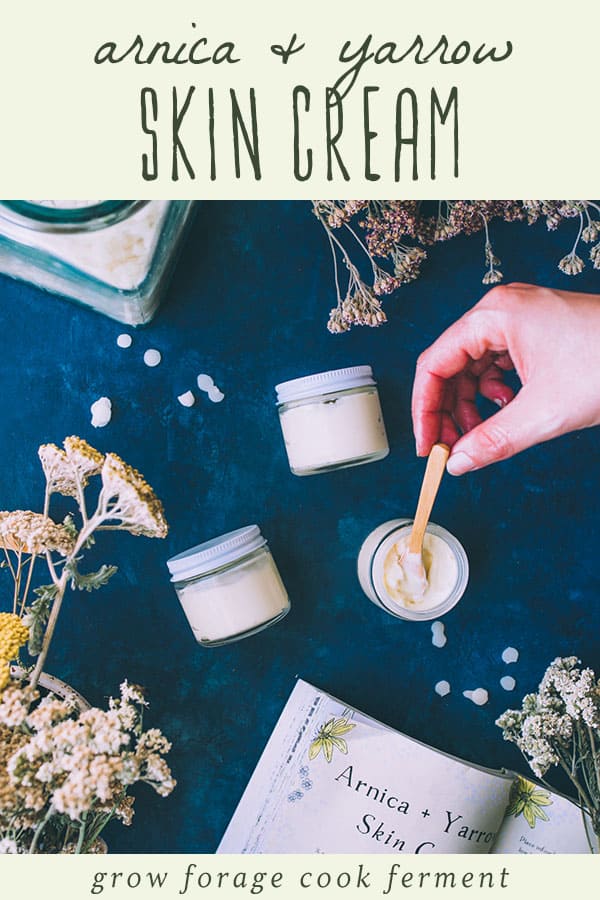
Want to save this post for later?
Botanical Skin Care Recipe Book by Herbal Academy
I made this lovely and moisturizing recipe for healing skin cream with arnica and yarrow from Botanical Skin Care Recipe Book by The Herbal Academy. This is a beautiful and useful recipe book that will cover all of your natural skin care needs.
With recipes for cleansers, blemish preparations, creams, body butters, hair care products, salves, scrubs, serums, and more, there is something for everyone!
Making your own skin care products is affordable, easy, and gives you a sound mind knowing exactly what you are putting on your skin.
There are so many of these recipes that would also make great gifts. Anyone would love these nature-inspired DIY products, so I encourage you to make some for yourself, and some to share!
The Herbal Academy also has a wonderful Botanical Skin Care course if you want to take your learning even further!
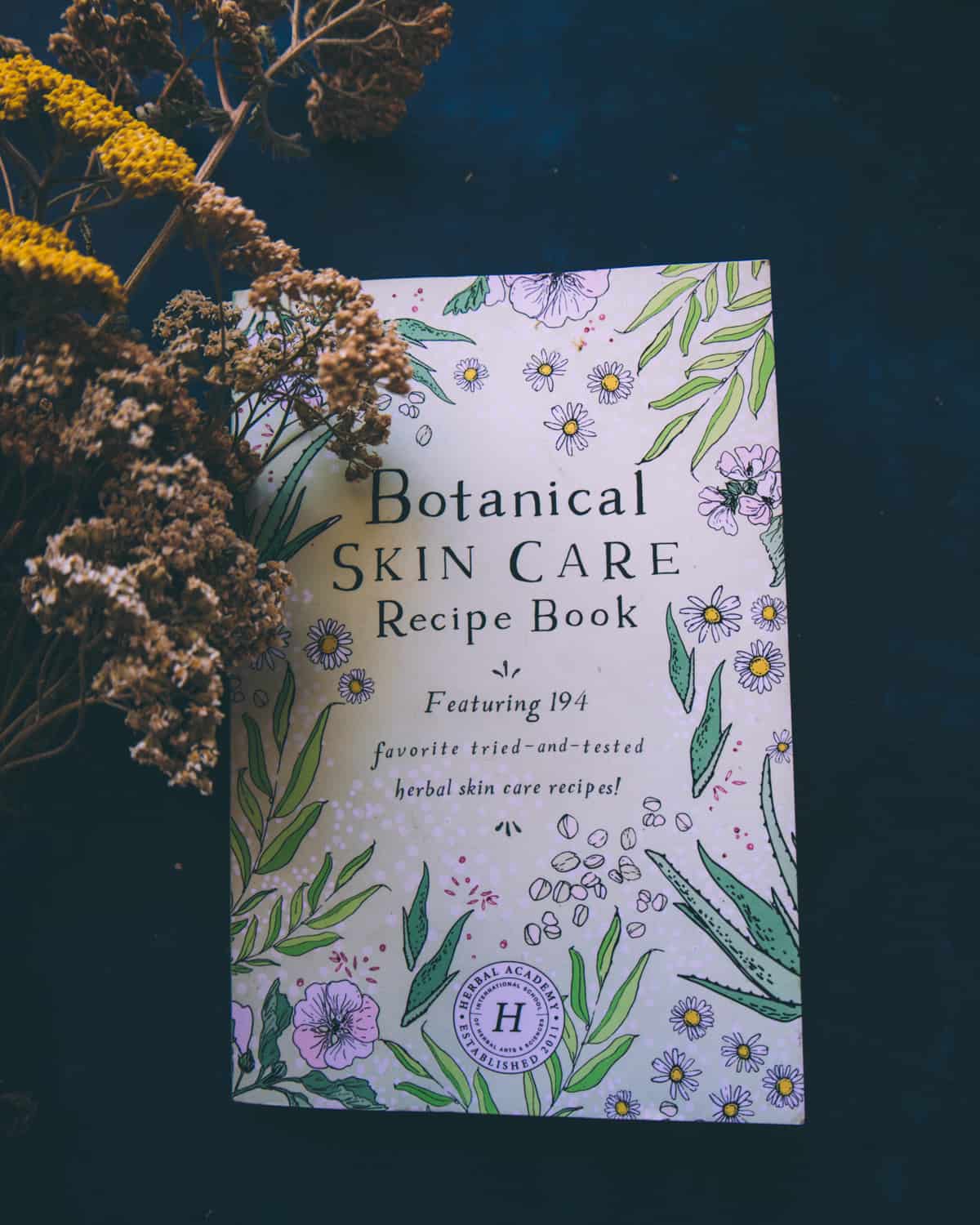
Arnica and Yarrow Skin Cream Recipe
Arnica oil is well known by herbalists, used for its analgesic, healing support, anti-inflammatory, and bruise reducing powers.
Yarrow’s antiseptic, astringent, and antimicrobial properties combine well with arnica to make this soft cream that works incredibly well for aches, pains, bruises, and injuries.
Make the Arnica-Infused Oil
The first step in making arnica and yarrow skin cream is to make an arnica-infused oil, similar to the process in my calendula cream recipe.
This can be done by putting dried arnica flowers into a jar and pouring the jojoba oil over to cover, and letting it sit for a few weeks to infuse.
You can also use a quick method of heating the oil and dried flowers in a pot on low heat for up to 12 hours.
You will need 1/4 cup of infused oil for this recipe, but note it’s always better to to make more than what the recipe calls for as the dried flowers do soak up a bit of the oil.
If have extra, you can use it for next time! It will keep for a good while, and is better to have too much rather than not enough.
Once the oil is finished infusing, strain out the flowers. The oil will have a yellow color.

Make the Yarrow Flower Infusion
To prepare the yarrow flower infusion tea, combine 2 tablespoons of fresh yarrow flowers or dried yarrow flowers and 1/2 cup of just boiled distilled water. Then cover and steep for 20 minutes, and strain.
Add the aloe vera gel to the yarrow tea.
If you are using a natural preservative that needs to be added with water, add that now and stir well. Otherwise, you can wait until after cream has emulsified. (See more about natural preservatives below).
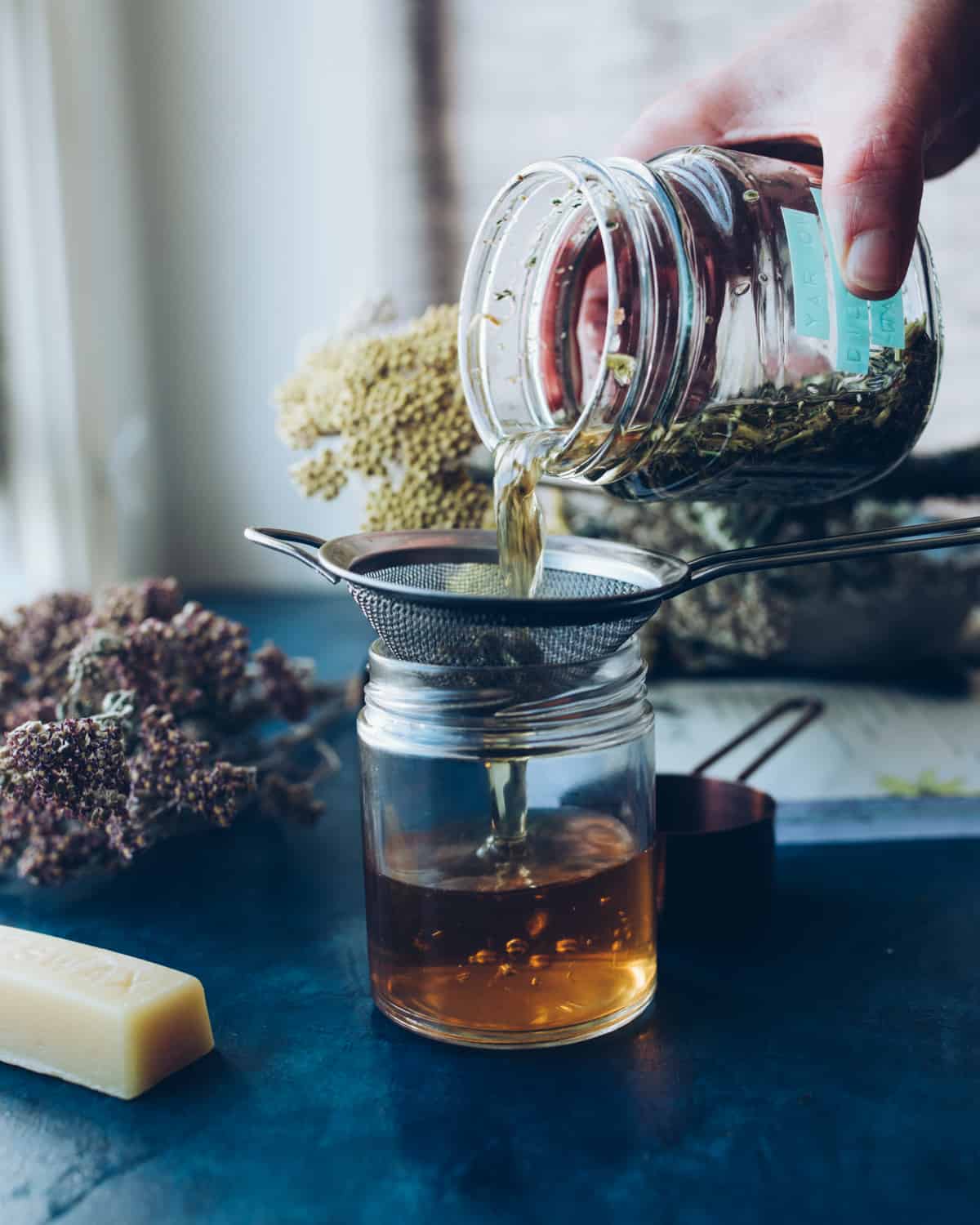
Make the Arnica and Yarrow Cream
Once your flower infusions are ready, add the arnica infused oil, mango butter, and beeswax in a double boiler over low heat until the beeswax and mango butter have melted.
If you don’t have a double boiler, a glass bowl over a saucepan of simmering water works just as well. Stir to blend.
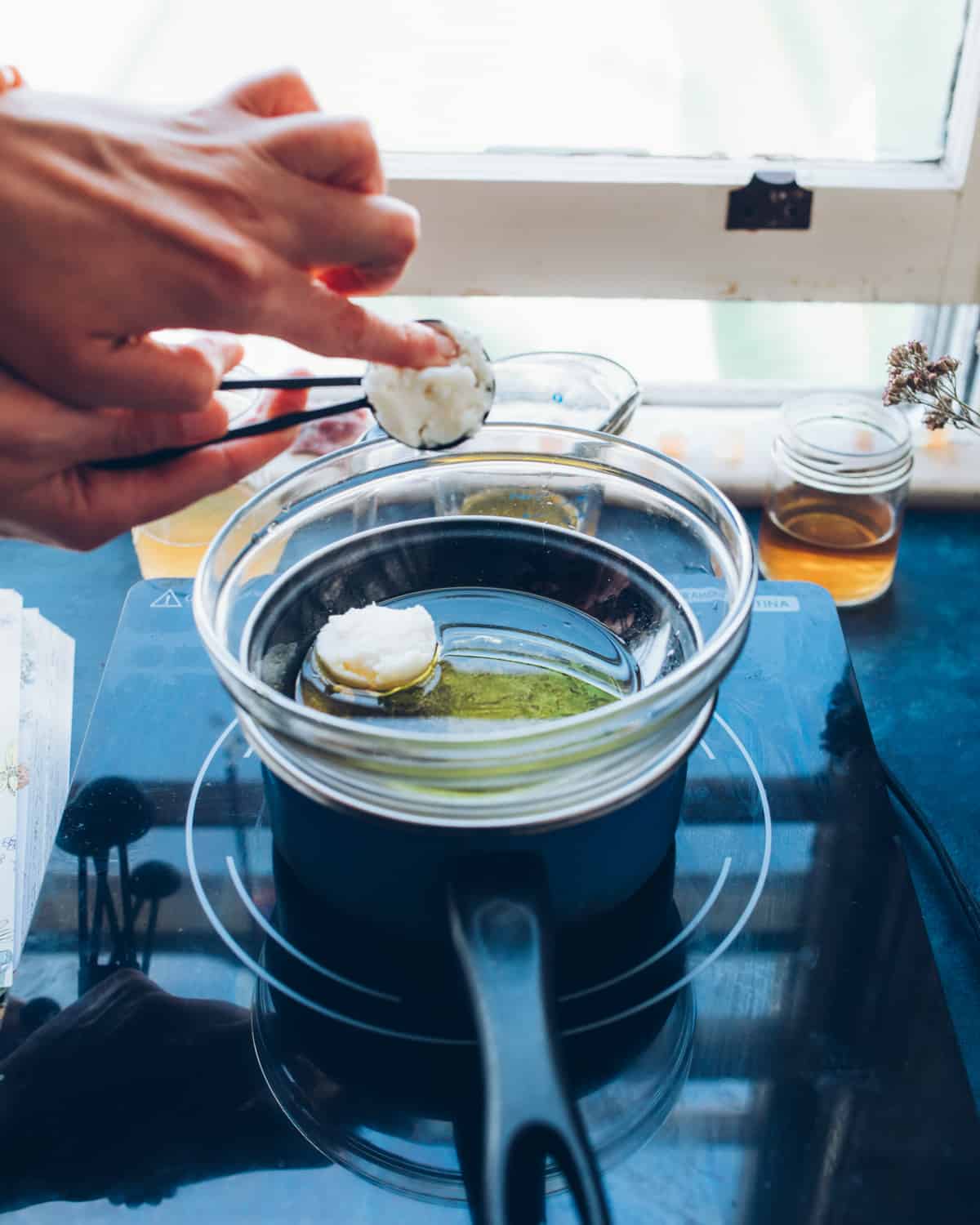
Remove from the heat, and transfer to a blender cool. If you are using an immersion blender, you can transfer to a bowl to cool.
When the oil mixture is cooled down to room temperature and has a creamy, semi-solid look, add the vitamin E oil.
Using the blender on low-medium setting, slowly add the yarrow infusion tea mixture to oil mixture while blender is on. You’ll see the mixture begin to emulsify and become creamy.
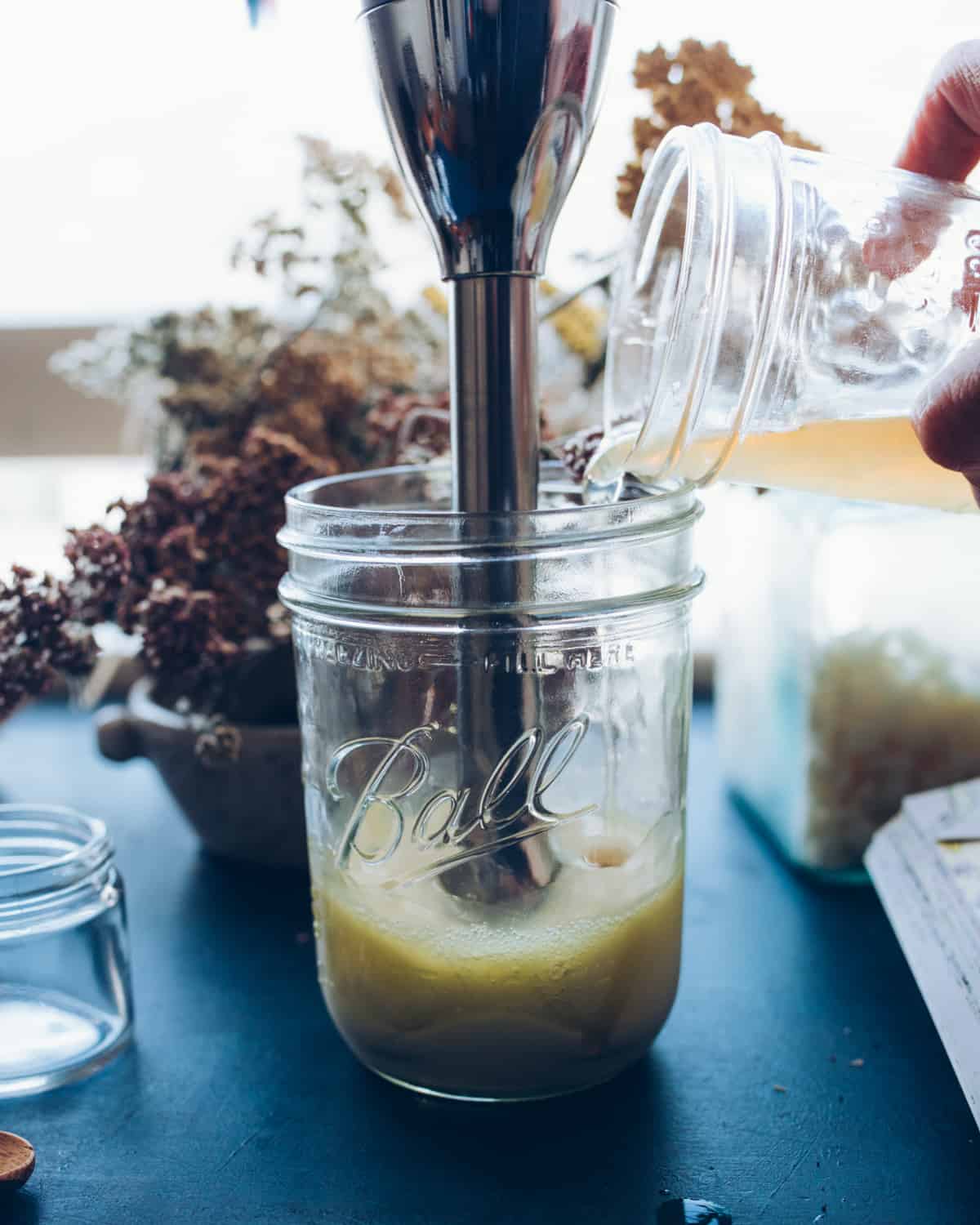
Make sure not to over-mix, and the cream will set as it cools.
Now pour the cream into sterilized glass jars!
Make sure to label them, and store in the refrigerator for 1-2 weeks if you decided not to use a preservative. If you did add a preservative, the shelf life will be longer.
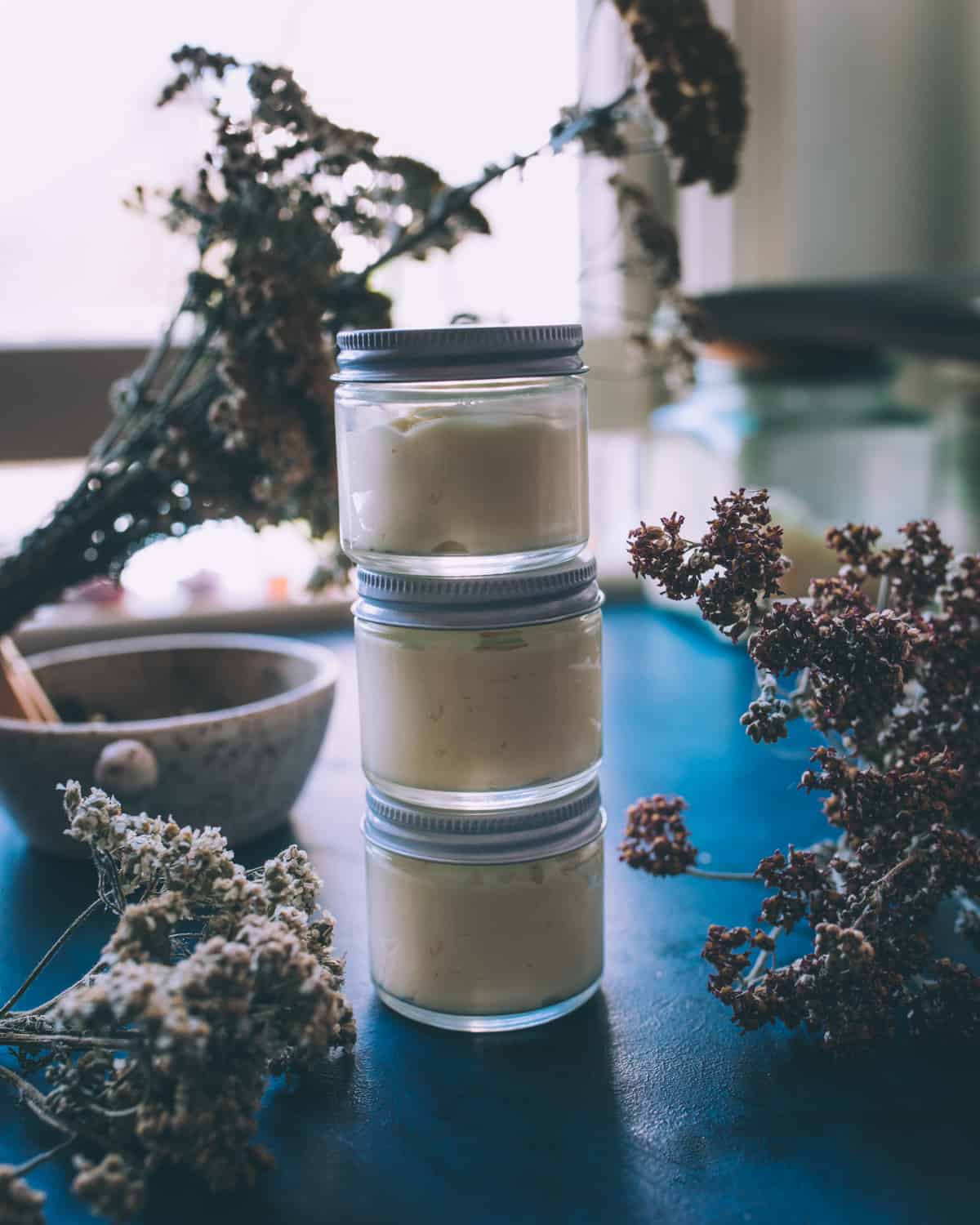
How to Use Arnica and Yarrow Cream
This homemade herbal arnica and yarrow cream has a thick and moisturizing consistency, similar to a body butter.
It can be used as a soothing moisturizer on hands or other areas that are in need, and also works wonderfully as a soothing cream for aches, pains, reducing bruising, and healing small injuries.
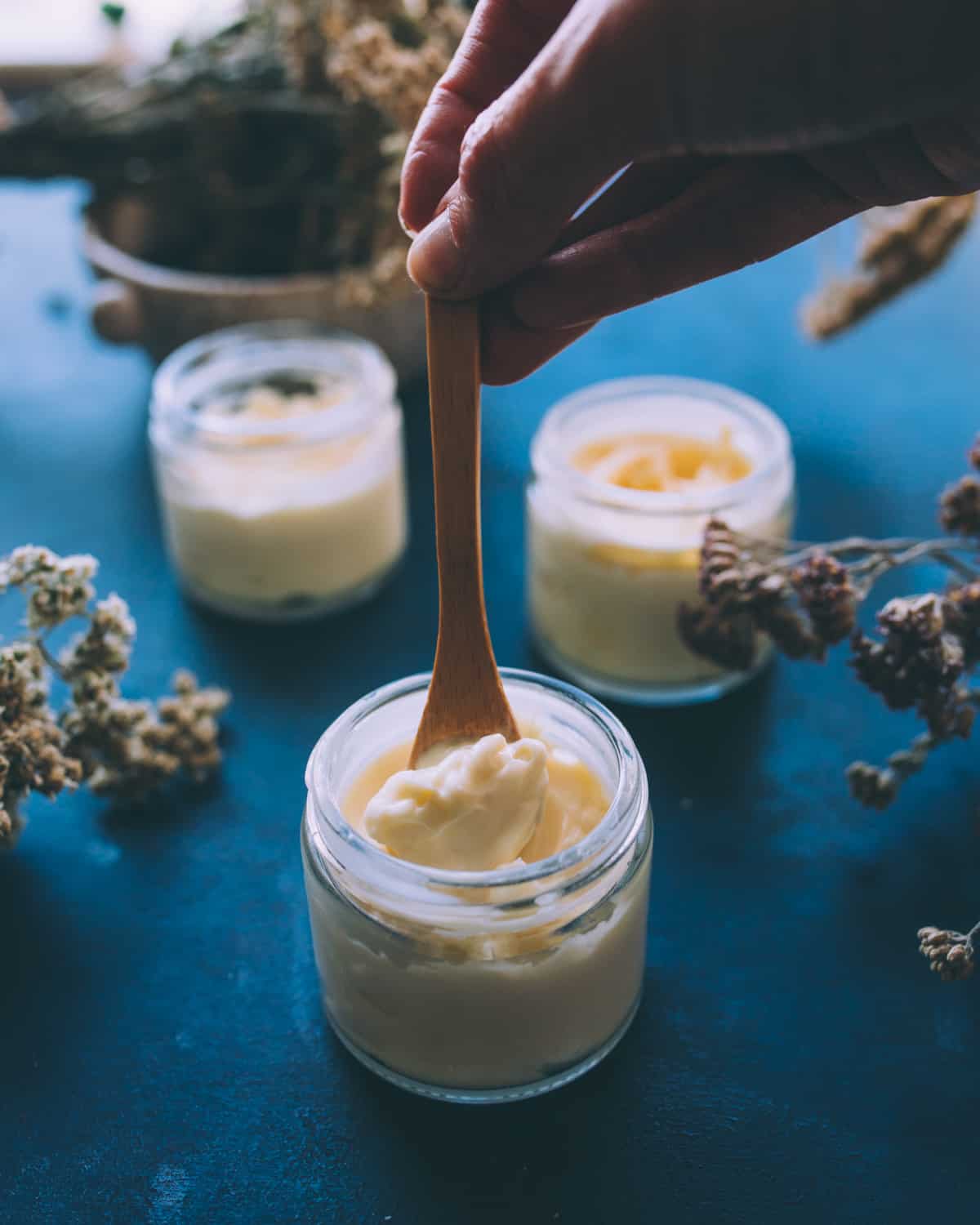
I find myself reaching for this cream regularly to use its powers for my whole family.
It soothes my skin and also my mind knowing exactly what ingredients are in it. I love that no harmful or toxic ingredients are in the mix!
Making your own creams and body care products in your home kitchen is easy to do and doubly rewarding. This particular cream has multiple uses, so making up a batch is totally worth it.
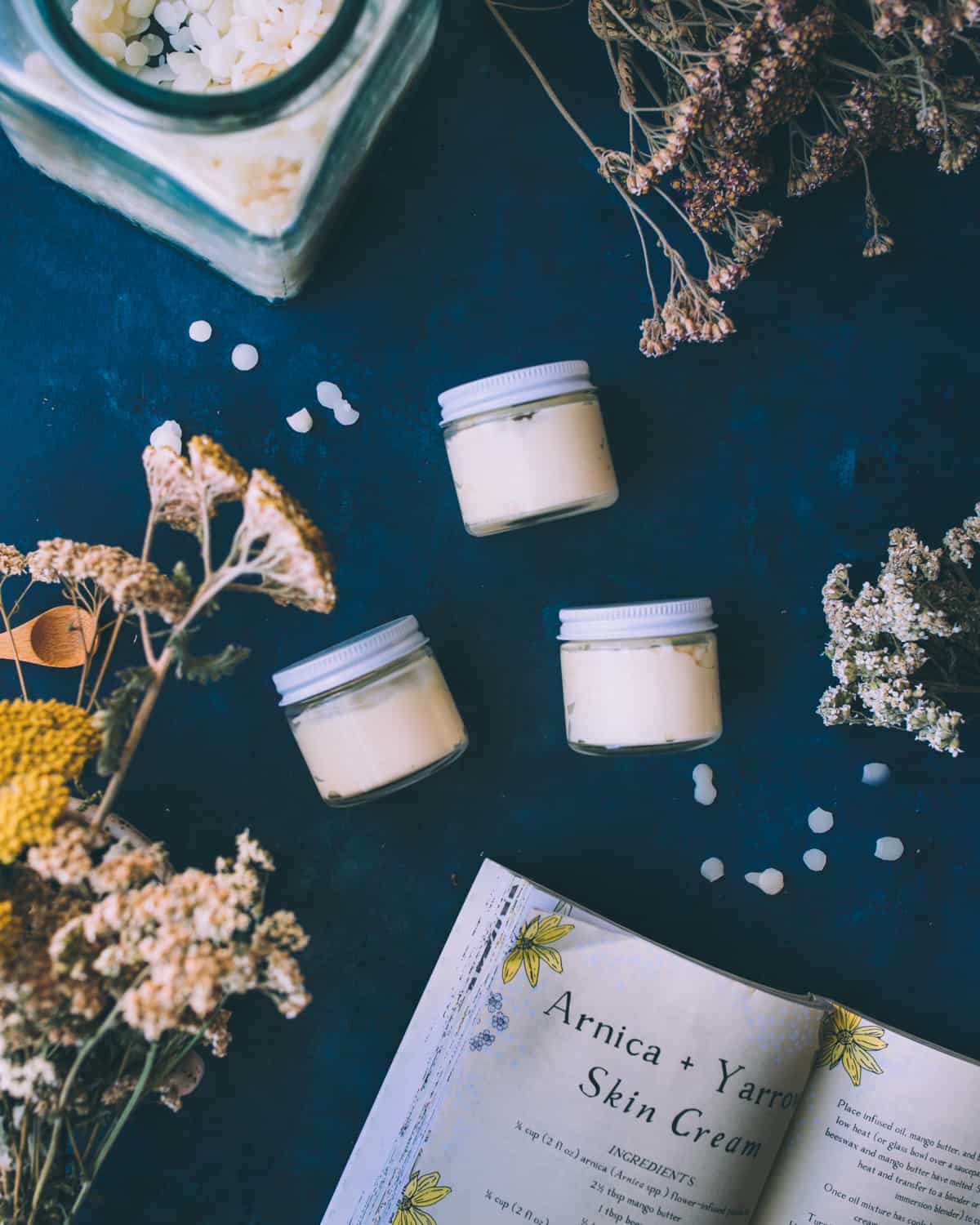
This arnica and yarrow cream has a comforting smell and is incredibly healing for body and mind.
Affordable to make and without taking much time, skip the store and make your own multi-purpose cream!
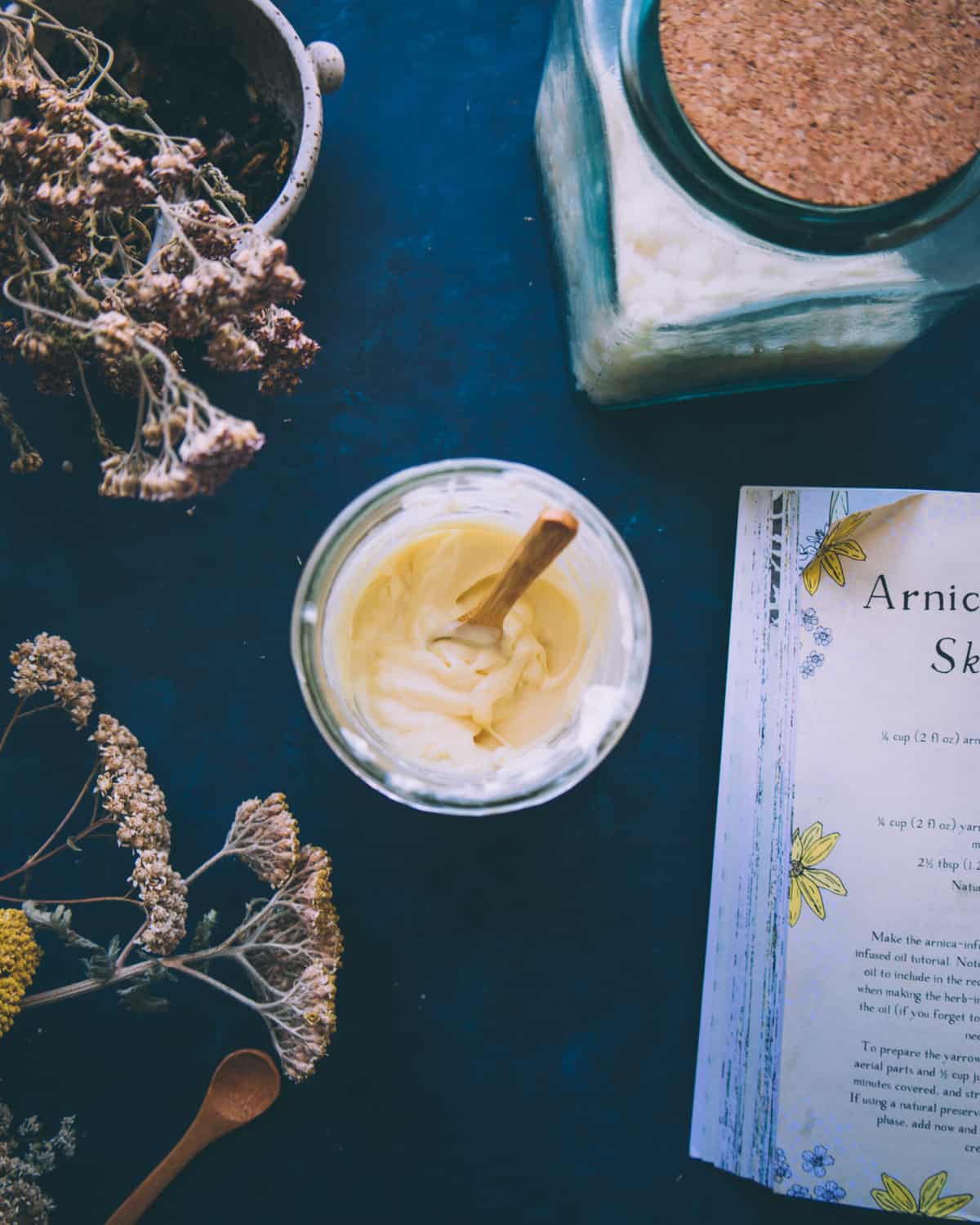
Do I Need to Use a Preservative for Arnica and Yarrow Cream?
In creams that are made with water, like this arnica and yarrow cream, it is best to use a preservative of some kind to prevent mold and other bacteria growing.
You *can* skip the preservative, but be aware that the shelf life of your cream will be very short (about 1-2 weeks), and you will also need to keep it in the refrigerator for the duration.
The Nerdy Farm Wife has some wonderful and factual information about natural preservatives for homemade lotion, I recommend you check it out to learn more.
If you want to jump right to 10 natural preservatives for homemade skin care, this is a great resource!
I chose to use Leucidal Complete Protection which is a natural preservative that works well.
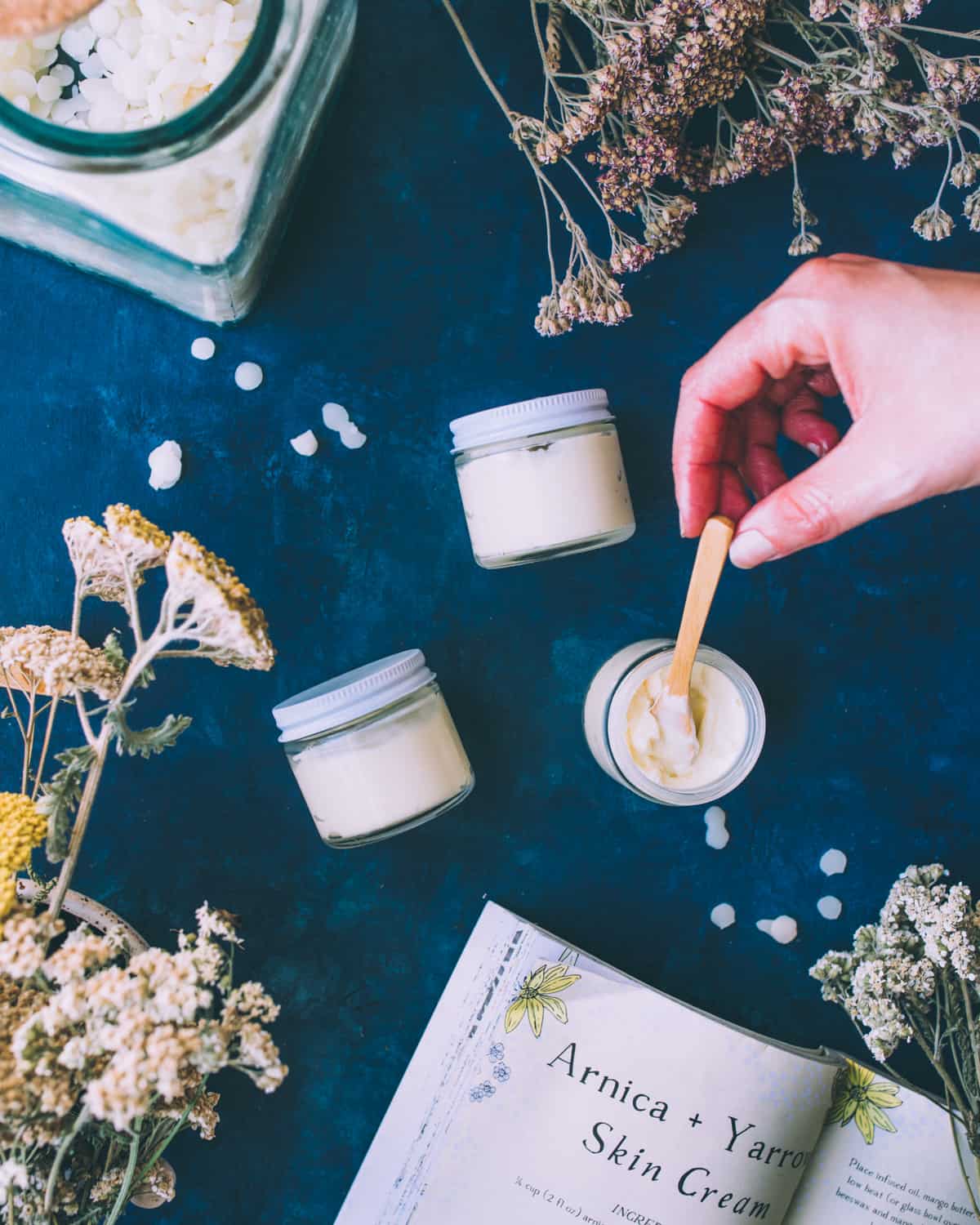
More Homemade Body Care Recipes
Find more DIY healing and soothing skin care recipes here!
- How to Make Calendula Cream
- Manuka Honey Salve with Propolis
- How to Make and Use Dandelion Salve
- Peppermint Coconut Sugar Scrub
- Juniper Spice Beard Balm
- Calendula Salve
- Wild Rose and Yarrow Soap
Looking for other homemade cream recipes? Try this DIY Eczema Cream with Colloidal Oatmeal or this Nourishing Rose Hand Cream, from The Nerdy Farm Wife!
I also highly recommend the Handmade Lotions & Creams ebook collection!
Arnica and Yarrow Skin Cream
Equipment
- Double Boiler
Ingredients
Arnica Infused Oil
- 1/4 cup dried arnica flowers
- 1/2 cup jojoba oil
Yarrow Flower Infusion
- 2 Tbsp dried yarrow flowers
- 1/2 cup distilled water
Arnica and Yarrow Skin Cream
- 1/4 cup yarrow flower infusion
- 2 1/2 tbsp aloe vera gel
- 1/4 cup arnica infused oil
- 2 1/2 tbsp mango butter
- 1 tbsp beeswax pastilles
- 1/2 tsp vitamin E oil
- 1/2 tsp Leucidal Complete Protection or another preservative (follow instructions on the bottle for amount to use)
Instructions
Arnica Infused Oil
- Put the dried arnica flowers into a jar and cover with the jojoba oil.
- Cover the jar and let it sit to infuse for several weeks.
Yarrow Flower Infusion
- Combine the yarrow flowers and boiling distilled water.
- Let steep for 20 minutes covered, then strain with a fine mesh sieve.
Arnica and Yarrow Skin Cream
- Measure out 1/4 cup of the yarrow tea and add the aloe vera gel.
- Place the arnica infused oil, mango butter, and beeswax in a double boiler over low heat (or a glass bowl over a saucepan of simmering water) until beeswax and mango butter have melted.
- Stir to blend.
- Remove from heat and transfer to a blender or a bowl (if using an immersion blender) to cool.
- Once oil mixture has cooled to room temperature and looks creamy and semi-solid, add vitamin E oil.
- Turning blender on low-medium setting or using an immersion blender in a bowl, slowly add yarrow infusion mixture to the oil mixture while blending. The mixture will begin to emulsify and become creamy. Avoid over-mixing. Cream will set up a bit more as it cools.
- Stir in the preservative if using.
- Pour the cream into sterilized glass jars, label, and store in the refrigerator for 1-2 weeks (if using a preservative, shelf life will be longer).
Notes
- Note that 1/4 cup is the amount of finished herbal oil to include in the recipe - you may need to start with more oil when making the herb-infused oil, as the herbs will soak up some of the oil.
- If you forget to do this, just top off with some plain oil as needed for this recipe.
- If using a natural preservative that needs to be added to the water phase, add it to the yarrow tea/aloe mixture and stir well: otherwise wait until after cream has emulsified to add the preservative.

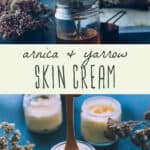
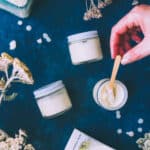

Why not infuse the yarrow into oil?
That’s not what I did for this recipe, but you certainly could.
I can’t wait to make this cream. It sounds so soothing. Already got my herbs steeping in the oil. Thanks for sharing Colleen.
You’re so welcome, Alicia. Enjoy!
Can I make this cream excluding dried arnica flowers? It seems difficult to find it in my area. Thank you previously!
Yes, definitely.
Can thi be made in the DIY setting on a Blusky appliance
Hi Mary. I’m honestly not sure what that is, so I can’t say. Sorry!
What could I use as a vegan substitute for the beeswax pastilles?
Hi Danielle. Candelilla wax is probably the most popular vegan alternative, but there are several more on the market you could try too.
Can I ask how much preservative you used in yours? I use the same brand.
TIA
The recipe uses 1/2 tsp.
Where do you buy the book from?
Hi Camille, you can buy the book here: Botanical Skin Care Recipe Book